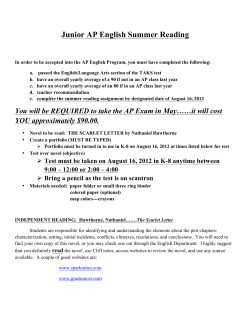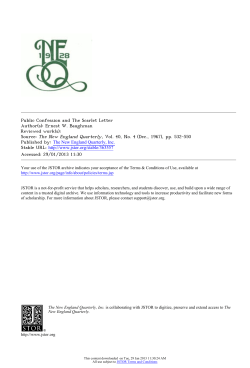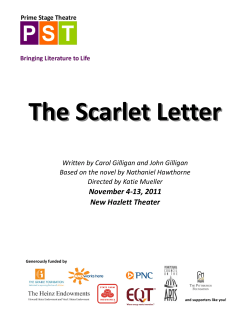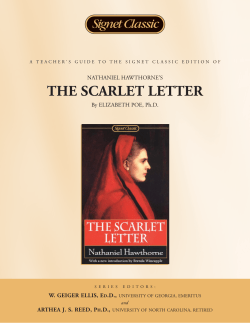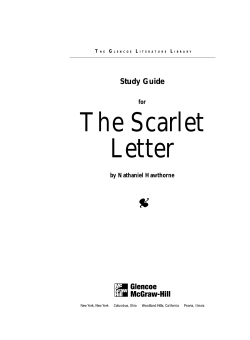
THE SCARLET LETTER by Nathaniel Hawthorne
THE SCARLET LETTER by Nathaniel Hawthorne THE AUTHOR Nathaniel Hawthorne (1804-1864) was the scion of an old New England family, the first of whom had arrived in Massachusetts Bay Colony in 1630; his son (and the author’s greatgrandfather) William Hathorne was one of the judges at the Salem Witch Trials in 1692 - an embarrassment that haunted the author and significantly influenced the ideas expressed in his most famous novel. Hawthorne was born in Salem, and from age four was cared for by his uncle following his father’s death. As a result of a childhood injury he became a voracious reader, and began to dabble in writing. After graduating from Bowdoin College, he devoted his time to writing, mostly short stories. He had trouble publishing them until a collection called Twice-Told Tales came out in 1838, to great public acclaim. After working briefly in the Custom House in Boston and living for seven months at the Brook Farm utopian community, he married Sophia Peabody in 1842. He again had trouble selling his writings and took a job at the Salem Custom House from 1846-1849. When the Democratic Party lost the 1848 election he lost his patronage job and turned again to writing, this time completing The Scarlet Letter in about six months and publishing it in 1850. The work received immediate public recognition and was considered by many the greatest work of American fiction yet written. In the two years that followed he produced The House of the Seven Gables, among other works. In 1852, his old friend and classmate Franklin Pierce was elected President, and Hawthorne was made U.S. consul in Liverpool, which ended his financial woes. He continued to write until his death in 1864. The Scarlet Letter reflects both the aesthetic of the Romantic Movement and the author’s deep hatred of the Puritans who had been his forebears. As a Romantic novel, it incorporates hints of the supernatural and a love for nature as the place of purity in contrast to the wickedness of civilization. It also deals with the emotions of the human heart rather than with sweeping and spectacular events. PLOT SUMMARY The story begins with a crowd of citizens gathering before the jail to observe the punishment of young Hester Prynne, who has borne a child out of wedlock. She emerges from the prison with an ornate letter “A” sewn on her dress and ascends the scaffold with her child, sentenced to stand in public before the gathered throng. At the edge of the crowd appears Roger Chillingworth, Hester’s husband, whom she has not seen in over two years. He is unknown to the citizens, though Hester recognizes him, and in conversation he expresses his belief that the father of the baby will ultimately be revealed. Meanwhile, John Wilson, chief pastor of Boston, leads a group of clergymen and government officials onto the balcony over the pillory and encourages the young pastor Arthur Dimmesdale to exhort the young woman to reveal the father of her baby. Dimmesdale does so, arguing that to name the man would be an act of mercy, enabling him to avoid adding hypocrisy to his other sins. She refuses, and Wilson then gives a long sermon on the perils of sin, after which Hester is returned to the prison. In the jail, Hester becomes hysterical and Pearl screams with colic. Chillingworth, claiming to be a doctor, gains access to the cell and offers potions to calm mother and baby. Hester, fearing that he is trying to kill them both, at first refuses, but when he swears he means them no harm, she accepts the drinks; she is calmed and the baby falls asleep. In the ensuing conversation, Chillingworth tells Hester that he is as much to blame for her fall as she because he forced her into a mismatched, loveless union. He assures her that he means her no harm, but that he will discover the father and force him to confess his wrong. He then makes her swear not to reveal his identity to the townspeople. After her release from prison, she determines to live out her life in New England despite the fact that she is legally free to go anywhere. She does so out of a sense that she is bound to the place, not only by guilt, but also by her union to the man with whom she had sinned, and hopes that her continuing suffering will purge her guilt in the end. She settles down in an abandoned cottage on the outskirts of town, where she supports herself and her daughter by needlework, which because of her skill comes to be quite in demand. She also sews garments for the poor. Through all this, she continues to be isolated and reviled by society, though she often feels a twinge in her breast when passing upright men or saintly women in the streets, almost as if the scarlet letter were reaching out to them to own a share in her guilt. Pearl grows into a beautiful child, and Hester dresses her in the finest clothing she is able to sew. The child is shunned by the others in the village and grows to hate them. She plays in the forest by herself, viciously tearing up weeds representing the adults and children of the town. Pearl behaves wildly, not susceptible to any discipline from her mother, and seems unduly fascinated with Hester’s scarlet letter. One day Hester hears a rumor that the colony is preparing to take Pearl away from her, so she takes her daughter and goes to appeal to Governor Bellingham for the right to keep her child. At the governor’s mansion, they encounter Bellingham along with Pastors Wilson and Dimmesdale and Roger Chillingworth, who has by now become Dimmesdale’s personal physician. The men are inclined to take Pearl away for her own good, but Dimmesdale passionately argues that, since God had given the child to Hester, it was His intention for her to raise her. With reservations they concur. As Hester and Pearl leave the mansion, Bellingham’s sister Mistress Hibbins, later burned as a witch, calls out the window and invites Hester to a black mass in the forest that night. Hester declines, but says she would have come had the authorities taken Pearl from her. Chillingworth, meanwhile, becomes increasingly accepted in the community. As Dimmesdale’s sickness worsens, the old man spends more and more time with him, until finally the two men move into a house together so the physician can constantly attend to his patient. During this time, Chillingworth engages in long discussions with Dimmesdale, penetrating into the depths of his psyche, and becomes more and more convinced that the respected pastor is carrying a guilty secret inside him. The townspeople, after initially being thankful for the doctor’s attentions to their beloved minister, soon come to view him as the devil incarnate. One day, the two men see Hester and Pearl walking in the nearby graveyard, and they discuss questions of guilt and its consequences. Later, Dimmesdale, who has with more frequency taken to pressing his hand to his breast as if in pain, falls asleep, and Chillingworth draws aside the poor man’s shirt and is startled to see, on his very breast, a scarlet letter like the one that adorns Hester (at this point in the book, the reader does not know what Chillingworth has seen, however). From this point on, the doctor takes his vengeance through psychological torture of the young minister. In addition to his physical infirmities, Dimmesdale begins to embark on prayer vigils and lengthy fasts, along with scourging, seeking to do penance for his sins. His suffering, however, makes him even more beloved by the members of his congregation. In his sin, he identifies with them, and when he speaks of his sin in general terms from the pulpit, they adore him for his sensitive conscience and think him the holiest of men. He also begins to stand vigil at night on the pillory on which Hester had been exposed ignominiously before the community. While on the scaffold, he both fears and desires discovery, but no one sees him except for Hester and Pearl, who are returning from keeping vigil beside the deathbed of old Governor Winthrop. He invites them to join him on the platform, and they comply, holding hands together in the place of shame. Pearl asks Dimmesdale if he will hold their hands at noon the next day, but he declines, telling her that they will stand together only at the day of judgment. Suddenly a meteor crosses the sky, illuminating the town with a ghostly red light, which seems to take the form of a red letter “A” in the heavens. Chillingworth then appears with a demonic expression on his face, but says no more than to convince Dimmesdale to accompany him home. The next day, the pastor preaches a great sermon, and is told by the church sexton that the red letter “A” in the sky the previous night must have stood for “Angel,” signifying the homegoing of Governor Winthrop. By this time Pearl is seven years old, and Hester has come to be more accepted in the community as a result of her care for the poor, sick, and dying, though she still lives in isolation from others, friendless and alone but for Pearl. Many of the people in the town now insist that the letter on her breast stands for “Able.” Hester has also lost all feminine softness and come to live in the realm of the mind, freethinker who would be a heretic of only her thoughts were known. After seeing the torture that Dimmesdale is experiencing at the hands of Chillingworth, however, she determines to do anything she can to relieve her fellow-sufferer’s agonies. A few days later, she meets Chillingworth while he is collecting herbs. Hester begs the old man to leave Dimmesdale alone, but he refuses. She then reveals her determination to violate her agreement and tell Dimmesdale the true identity of his tormentor, whatever the consequences may be. Chillingworth tells her to do as she pleases. After Chillingworth leaves, Hester retrieves Pearl, who has been playing by the sea and has fashioned a cloak and a green letter “A” out of seaweed and is wearing them. Pearl persists in asking Hester the significance of the scarlet letter, and why the minister always holds his hand on his heart. Hester, unwilling to tell the truth to a seven year old, lies and says she wears it because of the beauty of the gold thread with which it is embroidered. Several days later, she finds that Dimmesdale has traveled into the forest to visit John Eliot at his Indian mission. Hester takes Pearl into the forest in order to speak to Dimmesdale about Chillingworth. As they walk, Pearl asks if Hester has ever seen the Black Man who haunts the forest and entices people to sign their names in his book with blood, then leaves his mark on them; she also wants to know if the scarlet letter is the devil’s mark (Hester tells her it is), and if Dimmesdale holds his hand on his heart because he has the devil’s mark on his breast. When Dimmesdale comes into sight, Hester sends Pearl away to play. She tries to console Dimmesdale by speaking of the good he has done, but he refuses to acknowledge any good in himself. When she reveals that Chillingworth is her husband, he becomes angry with her for allowing him to be tortured by the old man, but forgives her when she begs him to do so. She urges him to flee the country and take up a new identity as a scholar, but he answers that he could never start a new life alone. Hester offers to go with him, but Dimmesdale agrees to do so. Overtaken by her newfound joy, Hester removes the scarlet letter, throws it from her, and lets down her hair to its full, luxuriant length. She then calls Pearl in order to introduce her to her father, but Pearl throws a tantrum and refuses to come until Hester replaces the scarlet letter and puts her hair back up. Even then, Pearl will not come to Dimmesdale, and when Hester forcibly brings her to him and he kisses her forehead, Pearl immediately runs to the stream and washes off the kiss. Hester and Dimmesdale planned to embark secretly on a ship sailing for Bristol four days hence, the day after Dimmesdale was to preach the Election Day sermon. As the pastor returns to the town, he feels a powerful urge to speak poison into the ears of the beloved members of the flock he encounters - words of heresy, despair, lechery, and blasphemy. He resists the urges, but feels that he has been changed irrevocably by his encounter with Hester in the forest. When he arrives home, Chillingworth enters his study and offers him medicine, but Dimmesdale answers that he feels unusually energetic and has no need of nostrums. He then casts his half-finished Election Day sermon into the fire and begins again, writing all night, seemingly under divine inspiration. When Election Day arrives, a crowd gathers in the town square made up of townspeople small and great, visitors from the countryside, Indians, and sailors. Soon Hester sees Chillingworth in deep conversation with the captain of the vessel she and Dimmesdale intend to take the following day. Later the captain approaches and informs her, to her horror, that the doctor has booked passage on the same vessel. The procession passes and enters the church, and Dimmesdale begins his sermon. Hester remains outside the church, standing by the scaffold, because the building lacks space to accommodate the vast crowd. Dimmesdale completes the sermon - the crowning achievement of his career - and leaves the church with the procession. After emerging, he pauses at the scaffold and calls Hester and Pearl to himself, asking them to help him ascend the steps. Chillingworth, fearing to lose his victim, begs him to turn back, but Dimmesdale is resolute. The strange family - Hester with her daughter, her lover, and her husband - slowly climb the ladder. There Dimmesdale confesses that he was Hester’s lover, and bares his breast to reveal a scarlet letter seared into his flesh. He summons Pearl, who kisses him, forgives Chillingworth, and dies. The old doctor, having no one left to torture, also dies within the year and leaves his substantial fortune to Pearl. Hester and Pearl disappear shortly thereafter. Many years pass, and Hester returns, reenters her tiny cabin, again puts on the scarlet letter, and becomes a wise and sought-after counselor to the women of the town. Pearl, now married and living far away, communicates with her regularly and sends her gifts for which she has no use. When Hester dies, beloved of all, she is buried next to Dimmesdale in the churchyard, with one tombstone serving for them both. MAJOR CHARACTERS • Hester Prynne - A young woman in sixteenth-century Boston who bears a child out of wedlock and is punished by having to wear a scarlet letter “A” on her dress. • Arthur Dimmesdale - The pastor of the local congregation and the father of Hester’s baby, the guilt he experiences ultimately leads to his death. • Roger Chillingworth - An elderly hunchbacked scholar and Hester’s estranged husband, he becomes Dimmesdale’s physician, then tortures him psychologically until he confesses his sin. • Pearl - Hester’s daughter, the issue of the illicit union. • Governor Bellingham - Governor of Massachusetts Bay Colony; like Mistress Hibbins, John Wilson, John Winthrop, and John Eliot, an actual historical figure woven into the story. • Mistress Hibbins - Bellingham’s sister, later burned as a witch. • John Wilson - The senior pastor of the settlement, a great and beloved Puritan scholar. NOTABLE QUOTATIONS “Finding it [the wild rosebush] so directly on the threshold of our narrative, which is now about to issue from that inauspicious portal, we could hardly do otherwise than pluck one of its flowers, and present it to the reader. It may serve, let us hope, to symbolize some sweet moral blossom, that may be found along the track, or relieve the darkening close of a tale of human frailty and sorrow.” (ch.1, p.56) “In either case, there was very much the same solemnity of demeanor on the part of the spectators; as befitted people amongst whom religion and law were almost identical, and in whose character both were so thoroughly interfused, that the mildest and the severest acts of public discipline were alike made venerable and awful.” (ch.2, p.57-58) “I charge thee to speak out the name of thy fellow-sinner and fellow-sufferer! Be not silent from any mistaken pity and tenderness for him; for, believe me, Hester, though he were to step down from a high place, and stand there beside thee, on thy pedestal of shame, yet better wee it so, than to hide a guilty heart through life. What can thy silence do for him, except to tempt him yea, compel him, as it were - to add hypocrisy to sin? Heaven hath granted thee an open ignominy, that thereby thou mayest work out an open triumph over the evil within thee, and the sorrow without. Take heed how thou deniest to him - who, perchance, hath not the courage to grasp it for himself - the bitter, but wholesome, cup that is now presented to thy lips!” (Dimmesdale, ch.3, p.77) “I shall seek this man, as I have sought truth in books; as I have sought gold in alchemy. There is a sympathy that will make me conscious of him. I shall see him tremble. I shall feel myself shudder, suddenly and unawares. Sooner or later, he must needs be mine!” (Chillingworth, ch.4, p.86) “Art thou like the Black Man that haunts the forest round about us? Hast thou enticed me into a bond that will prove the ruin of my soul?” “Not, thy soul. No, not thine!” (Hester and Chillingworth, ch.4, p.87-88) “Here, she said to herself, had been the scene of her guilt, and here should be the scene of her earthly punishment; and so, perchance the torture of her daily shame would at length purge her soul, and work out another purity than that which she had lost; more saint-like, because the result of martyrdom.” (ch.5, p.92) “But she named the child ‘Pearl,’ as being of great price - purchased with all she had - her mother’s only treasure!” (ch.6, p.101) “The child could not be made amenable to rules.” (ch.6, p.103) “So Roger Chillingworth - the man of skill, the kind and friendly physician - strove to go deep into his patient’s bosom, delving among his principles, prying into his recollections, and probing everything with a cautious touch, like a treasure-seeker in a dark cavern. Few secrets can escape an investigator, who has opportunity and license to undertake such a quest, and skill to follow it up. A man burdened with a secret should especially avoid the intimacy of his physician.” (ch.9, p.140) “To sum up the matter, it grew to be a widely diffused opinion, that the Reverend Arthur Dimmesdale, like many other personages of especial sanctity, in all ages of the Christian world, was haunted either by Satan himself, or Satan’s emissary, in the guise of old Roger Chillingworth.” (ch.9, p.144) “But still, methinks, it must needs be better for the sufferer to be free to show his pain, as this poor woman Hester is, than to cover it all up in his heart.” (Dimmesdale, ch.10, p.153) “Come up hither, Hester, thou and little Pearl. Ye have both been here before, but I was not with you. Come up hither once again, and we will stand all three together!” (Dimmesdale, ch.12, p.173) “Had seven long years, under the torture of the scarlet letter, inflicted so much misery, and wrought out no repentance?” (ch.15, p.201) “Once in my life I met the Black Man! This scarlet letter is his mark!” (Hester, ch.16, p.211) “Of penance, I have had enough! Of penitence, there has been none!” (Dimmesdale, ch.17, p.218) “Let God punish! Thou shalt forgive!” (Hester, ch.17, p.221) “Thou shalt not go alone!” (Hester, ch.17, p.226) “She had wandered, without rule or guidance, in a moral wilderness; as vast, as intricate and shadowy, as the untamed forest, amid the gloom of which they were now holding a colloquy that was to decide their fate.” (ch.18, p.227) “So speaking, she undid the clasp that fastened the scarlet letter, and, taking it from her bosom, threw it to a distance among the withered leaves.” (ch.18, p.230) “No man, for any considerable period, can wear one face to himself, and another to the multitude, without finally getting bewildered as to which may be the true.” (ch.20, p.246) “That self was gone. Another man had returned out of the forest; a wiser one; with a knowledge of hidden mysteries which the simplicity of the former never could have reached. A bitter kind of knowledge that!” (ch.20, p.254) “Hadst thou sought the whole earth over, there was no place so secret - no high place nor no lowly place, where thou couldst have escaped me - save on this very scaffold!” (Chillingworth, ch.23, p.288) “Be true! Be true! Be true! Show freely to the world, if not your worst, yet some trait whereby the worst may be inferred!” (Hawthorne, ch.24, p.295) “It is a curious subject of observation and inquiry whether hatred and love be not the same thing at bottom. Each, in its utmost development, supposes a high degree of intimacy and heartknowledge; each renders one individual dependent for the food of his affections and spiritual life upon another; each leaves the passionate lover, or the no less passionate hater, forlorn and desolate by the withdrawal of his subject.” (ch.24, p.295-296) ESSAY QUESTIONS Discuss the following in a five-paragraph essay: 1. The subtitle of Nathaniel Hawthorne’s The Scarlet Letter is A Romance. In what sense is the famous novel rightly described as a romance? Consider the Romantic Movement of which Hawthorne was a part in formulating your answer, and support your arguments with details from the novel. 2. Discuss the use of the images of light and darkness in Nathaniel Hawthorne’s The Scarlet Letter. Choose specific incidents or quotations in which the images are used for different purposes in order to explain the richness of the image in the novel. 3. Nathaniel Hawthorne was fascinated by the history of colonial New England, and read everything he could get his hands on about the subject. His great novel The Scarlet Letter contains touches of authenticity that result from his extensive researches. Hawthorne also felt a deep hatred and shame for the Puritans, stemming largely from the fact that his ancestor, Judge Hathorne (Nathaniel changed the spelling of the name to dissociate himself from the old man), had been one of the judges at the Salem witch trials. From your knowledge of the Puritans, which characteristic of the author dominates his description of life in colonial New England - his authentic knowledge of the era or his visceral hatred for its people? To what extent does he “get the Puritans right”? To what extent does this internal conflict influence the tone and themes of the novel? 4. Discuss the imagery of the color red in Nathaniel Hawthorne’s The Scarlet Letter. Choose specific incidents or quotations in which the image is used for different purposes in order to explain the richness of the image in the novel. 5. In Nathaniel Hawthorne’s The Scarlet Letter, the author uses the contrast between the town and the forest to communicate the themes of the novel. Discuss the nature of this contrast. Be sure to incorporate specific quotations into your essay, and include comments on how the contrast reflects the philosophy and worldview of the novelist. 6. In the conclusion of Nathaniel Hawthorne’s The Scarlet Letter, the author himself presents the moral of his story: “Be true! Be true! Be true! Show freely to the world, if not your worst, yet some trait whereby the worst may be inferred!” What do you think he means by these words? If this is indeed the message of the novel, is it a biblical one? Why or why not? Support your conclusion from the novel and from Scripture. 7. Discuss the concept of human nature found in Nathaniel Hawthorne’s The Scarlet Letter. Focus particularly on his understanding of human sinfulness. Is his view biblical? Why or why not? Support your conclusion with specific incidents and quotations from the novel. 8. Discuss the concept of redemption found in Nathaniel Hawthorne’s The Scarlet Letter. Focus particularly on his understanding of the role of repentance in redemption. Is his view biblical? Why or why not? Support your conclusion with specific incidents and quotations from the novel. 9. What is the difference between penance and repentance? In what ways do the two ideas imply different understandings of the nature of salvation? Develop your arguments by using incidents and quotations from Nathaniel Hawthorne’s The Scarlet Letter. Be sure to indicate where Hawthorne’s great novel falls in communicating these issues. 10. Discuss the ideas concerning the consequences of sin reflected in Nathaniel Hawthorne’s The Scarlet Letter. What consequences does sin have for the individual sinner? for those close to him or her? for the community? Be sure to use specifics from the novel to support your arguments. 11. “‘It is mine to avenge; I will repay,’ says the Lord” (Romans 12:19). What does Nathaniel Hawthorne’s The Scarlet Letter communicate concerning the subject of revenge? Would he agree with Paul’s repudiation of vengeance? Focus especially on the character of Roger Chillingworth as you answer the question, and be sure to use supporting quotations from the novel. 12. Alienation is a major theme in Nathaniel Hawthorne’s The Scarlet Letter. Does the author present alienation more as the result of decisions made by individuals or the result of the actions of the larger society? Does it come more from within or without? Support your conclusion with quotations from the novel. 13. In Nathaniel Hawthorne’s The Scarlet Letter, compare and contrast the two men in Hester Prynne’s life. Are Dimmesdale and Chillingworth intended to be foils, bringing out their respective characteristics by the striking differences between the two men, or do they have similarities as well? Be sure to explain how their connections play an important role in communicating the major themes of the novel. 14. Analyze the role of the child Pearl in Nathaniel Hawthorne’s The Scarlet Letter. Of what is she a symbol (note that Hawthorne draws the character so richly that she is used as a symbol of many things)? Why is she a necessary component in the story with regard to its major themes? 15. Discuss the significance of the scaffold in Nathaniel Hawthorne’s The Scarlet Letter. Devote a paragraph to each of the three scenes in which it plays a major role, and explain how the symbolism associated with it relates to the ideas Hawthorne seeks to express in the novel. 16. In Nathaniel Hawthorne’s The Scarlet Letter, Roger Chillingworth passes himself off as a doctor, colloquially referred to as a “leech.” Why is this description an appropriate one for Hester’s estranged husband? Be sure to consider incidents from his initial relationship with Hester through his death at the end of the story. 17. In Nathaniel Hawthorne’s The Scarlet Letter, compare the consequences of the sin of Hester and Dimmesdale with that of Adam and Eve in the Garden of Eden. Consider both immediate and short-term consequences in your answer. Did Hawthorne believe that the “fall” of his characters produced unmitigated evil, or did he think it produced good in them as well? What does this suggest about his worldview? 18. As portrayed in Nathaniel Hawthorne’s The Scarlet Letter, what is the essence of evil? Is it something inside man or outside of him? Is it inborn or chosen? Evaluate Hawthorne’s view of the nature of evil from the standpoint of Scripture. Be sure to use quotations from both the book and the Bible in your answer. 19. Discuss the changing meaning of Hester Prynne’s scarlet letter in Nathaniel Hawthorne’s The Scarlet Letter. What do the shifts in meaning tell us about Hester? about the community in which she lives? How do these changes relate to the overall themes of the novel? 20. Discuss the connection between the scarlet letter and the child Pearl in Nathaniel Hawthorne’s The Scarlet Letter. In what sense is the child the embodiment of Hester’s emblem? How does Pearl, in her behavior and speech, give the reader insight into the impact of the intended mark of shame on its wearer? 21. In Nathaniel Hawthorne’s The Scarlet Letter, discuss the author’s understanding of repentance, giving special attention to the character of Arthur Dimmesdale. Does Dimmesdale ever truly repent? What are the consequences of public repentance of sin? of refusing to repent? Is Hawthorne’s understanding of repentance a biblical one? 22. Compare and contrast the views of Hester’s adultery expressed by Hester herself, the townspeople, and the author in Nathaniel Hawthorne’s The Scarlet Letter. Analyze each in relationship to the biblical teaching on the subject. 23. Compare and contrast the view of American Puritanism expressed in Nathaniel Hawthorne’s The Scarlet Letter with what you know of the actual founders and early inhabitants of Massachusetts Bay Colony. In your opinion, did Hawthorne hate the Puritans because he knew only a caricature of their society, or did he caricature their society because he hated what they stood for? Support your arguments with details from the novel. 24. Compare and contrast Nathaniel Hawthorne’s The Scarlet Letter with the story of the woman taken in adultery in John 8. In what ways does the treatment Jesus accorded the woman serve as a critique of the Puritan community pictured in Hawthorne’s novel? Be sure to go beyond merely saying that Jesus forgave the woman while the Puritans did not forgive Hester. 25. Compare and contrast the functions of the color red in the clothing of Hester Prynne in Nathaniel Hawthorne’s The Scarlet Letter and Mattie Silver in Edith Wharton’s Ethan Frome. In what ways do the red adornments symbolize the same things? How do the authors use those symbols differently? 26. Compare and contrast the pictures and consequences of Puritan morality presented in Nathaniel Hawthorne’s The Scarlet Letter and Edith Wharton’s Ethan Frome. Though the settings in time are radically different, the same moral sensibilities pervade both stories. What do the respective authors consider to be the essence of the moral ideas that have shaped New England? What is their evaluation of these moral standards? Use quotations and incidents from both novels to support your evaluation. 27. Herman Melville for many years was a friend and neighbor of Nathaniel Hawthorne. In fact, he dedicated Moby Dick to Hawthorne, who had encouraged him during the writing process. Compare and contrast the views of evil presented in the greatest novels of the two authors, Herman Melville’s Moby Dick and Nathaniel Hawthorne’s The Scarlet Letter. How were the two men alike in their view of evil in the world? How were they different? 28. Compare and contrast the portrayals of the Massachusetts Bay Puritans found in Nathaniel Hawthorne’s The Scarlet Letter and Arthur Miller’s The Crucible. Why are both writers so antagonistic toward what was in reality a godly group of people despite their obvious faults? In what ways do the two portrayals differ, and what do these differences reveal about the purposes of the authors? 29. Nathaniel Hawthorne was descended from one of the judges involved in the infamous Salem Witch Trials and always resented what he considered to be a blot on the family name. His hatred for the Puritans appears in many of his works, including both The Scarlet Letter and The House of the Seven Gables. The two novels, however, express the author’s bitterness in very different ways. Compare and contrast the views of the Puritans presented in the two works. Which do you consider to be the more harmful critique of Hawthorne’s forebears, and why?
© Copyright 2025
